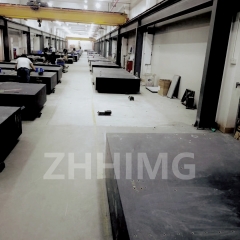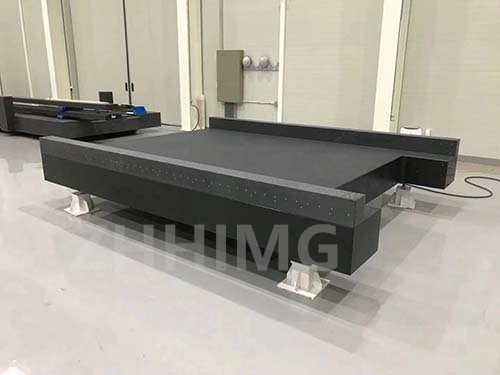In the field of precision manufacturing and inspection, the thermal deformation performance of materials is a key factor determining the accuracy and reliability of equipment. Granite and cast iron, as two commonly used industrial basic materials, have attracted much attention for their performance differences in high-temperature environments. To visually present the thermal deformation characteristics of both, we used a professional thermal imager to conduct continuous 8-hour working tests on granite and cast iron platforms of the same specification, revealing the real differences through data and images.

Experimental design: Simulate harsh working conditions and accurately capture differences
For this experiment, granite and cast iron platforms with dimensions of 1000mm×600mm×100mm were selected. In a simulated industrial workshop environment (temperature 25±1℃, humidity 50%±5%), by evenly distributing heat sources on the platform surface (simulating the heat generation during equipment operation), the platform worked continuously at a power of 100W for 8 hours. The FLIR T1040 thermal imager (with a temperature resolution of 0.02℃) and the high-precision laser displacement sensor (with an accuracy of ±0.1μm) were used to monitor the temperature distribution and deformation of the platform surface in real time, and the data was recorded once every 30 minutes.
Measured results: Visualize the temperature difference and quantify the deformation gap
The data from the thermal imager shows that after the cast iron platform has been working for one hour, the maximum surface temperature has reached 42℃, which is 17℃ higher than the initial temperature. Eight hours later, the temperature rose to 58℃, and a distinct temperature gradient distribution emerged, with a temperature difference of 8℃ between the edge and the center. The heating process of the granite platform is more gentle. The temperature only rises to 28℃ after 1 hour and stabilizes at 32℃ after 8 hours. The surface temperature difference is controlled within 2℃.
According to the deformation data, within 8 hours, the vertical deformation in the center area of the cast iron platform reached 0.18mm, and the warping deformation at the edge was 0.07mm. In contrast, the maximum deformation of the granite platform is only 0.02mm, less than 1/9 of that of the cast iron one. The real-time curve of the laser displacement sensor also confirms this result: The deformation curve of the cast iron platform fluctuates sharply, while the curve of the granite platform is nearly stable, demonstrating extremely strong thermal stability.
Principle analysis: Material properties determine the differences in thermal deformation
The root cause of the significant thermal deformation of cast iron lies in its relatively high coefficient of thermal expansion (approximately 10-12 ×10⁻⁶/℃), and the uneven distribution of graphite inside, resulting in inconsistent heat conduction velocities and the formation of local thermal stress concentration. Meanwhile, cast iron has a relatively low specific heat capacity, and its temperature rises faster when absorbing the same amount of heat. In contrast, the coefficient of thermal expansion of granite is only (4-8) ×10⁻⁶/℃. Its crystal structure is dense and uniform, with low and evenly distributed heat conduction efficiency. Coupled with its high specific heat capacity characteristic, it can still maintain dimensional stability in high-temperature environments.
Application enlightenment: Choice determines precision, stability creates value
In equipment such as precision machine tools and three-coordinate measuring machines, the thermal deformation of cast iron bases can lead to processing or inspection errors, affecting the yield of qualified products. The granite base, with its outstanding thermal stability, can ensure that the equipment maintains high precision during long-term operation. After a certain automotive parts manufacturing enterprise replaced the cast iron platform with a granite platform, the dimensional error rate of precision parts decreased from 3.2% to 0.8%, and the production efficiency increased by 15%.
Through the intuitive presentation and precise measurement of the thermal imager, the difference in thermal deformation between granite and cast iron is immediately apparent. In modern industry that pursues ultimate precision, choosing granite materials with stronger thermal stability is undoubtedly a wise move to enhance equipment performance and ensure product quality.
Post time: May-24-2025

